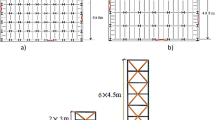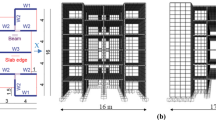Abstract
Finite element models supply the simulation of the problems to obtain the structural behaviors under different loading conditions. The updating processes based on changing the uncertain parameters such as material properties, boundary conditions, meshing size etc. are made to create actual finite element models in order to represent the real conditions of the problems. This procedure can be made using two methods, namely manual model updating and global/local automatic model updating. The global/local automatic model updating procedures are very popular owing to the applicability to all kind of engineering structures, minimizing the differences nearly to zero, availability of damage localization and structural health monitoring. In this paper a historical masonry armory building selected as an application and its finite element analyses, experimental measurements and automated model updating processes are carried out. The finite element model of the structures was developed with ANSYS software and first three natural frequencies are attained. The experimental dynamic characteristics such as natural frequencies, damping ratios and mode shapes are obtained using ambient vibration method. The differences between experimental and numerical frequencies are minimized up to the range of 0–1%, by using local updating procedure. The linear and nonlinear seismic analyses of the building are conducted on initial and updated models. At the end of the analyses, maximum displacements, principal stresses and strains are given with detail. In addition, crack distributions diagrams are attained to validate the stresses accumulation points. It can be seen that there is an increasing trend in the displacement, stress and strain values after finite element model updating both linear and nonlinear analysis. In addition, linear and nonlinear analysis results are compared with each other to evaluate the nonlinear analysis effect. It is concluded that the displacement and strain values are increased after nonlinear analysis. But, there is not any agreement in stress values.























Similar content being viewed by others
References
Madenci, E. and Guven, I. (2006), The finite element method and Applications in engineering using ANSYS®, Springer US https://doi.org/10.1007/978-0-387-28290-9
Sevim B, Bayraktar A, Altunişik AC, Atamtürktür S, Birinci F (2011) Finite element model calibration effects on the earthquake response of masonry arch bridges. Finite Elem Anal Des 47(7):621–634
Saisi A, Gentile C, Guidobaldi M (2015) Post-earthquake continuous dynamic monitoring of the Gabbia tower in mantua, Italy. Constr Build Mater 81:101–112
Zivanovic S, Pavic A, Reynolds P (2007) Finite element modelling and updating of a lively footbridge: the complete process. J Sound Vib 301(1):126–145
Atamturktur S, Laman JA (2012) Finite element model correlation and calibration of historic masonry monuments, the structural Design of Tall and Special. Buildings 21(2):96–113
Sevim B, Bayraktar A, Altunışık AC (2011) Finite element model calibration of Berke arch dam using operational modal testing. J Vib Control 17(7):1065–1079
Altunışık AC, Günaydın M, Sevim B, Bayraktar A, Adanur S (2015) CFRP composite retrofitting effect on the dynamic characteristics of arch dams. Soil Dyn Earthq Eng 74:1–9
Turker T, Bayraktar A, Sevim B (2014) Vibration based damage identification of concrete arch dams by finite element model updating. Comput Concr 13(2):209–220
Brownjohn JMW, Dumanoğlu AA, Severn RT (1992) Ambient vibration survey of the Fatih sultan Mehmet (second Bosporus) suspension bridge. Earthq Eng Struct Dyn 21:907–924
Altunışık AC, Bayraktar A, Sevim B, Özdemir H (2011) Experimental and analytical system identification of Eynel arch type steel highway bridge. J Constr Steel Res 67(12):1912–1921
Ribeiro D, Calçada R, Delgado R, Brehm M, Zabel V (2012) Finite element model updating of a bowstring-arch railway bridge based on experimental modal parameters. Eng Struct 40:413–435
Zapico JL, Gonzalez MP, Friswell MI, Taylor CA, Crewe AJ (2003) Finite element model updating of a small scale bridge. J Sound Vib 268:993–1012
Chen, X., Omenzetter, P. and Beskhyroun, S. (2014), Calibration of the finite element model of a twelve-span prestressed concrete bridge using ambient vibration data, 7th European workshop on structural health monitoring, Nantes, France.
Zordan T, Briseghella B, Liu T (2014) Finite element model updating of a tied-arch bridge using Douglas-Reid method and Rosenbrock optimization algorithm. J Traffıc Trans Eng 1(4):280–292
Sanayei M, Khaloo A, Gul M, Catbas FN (2015) Automated finite element model updating of a scale bridge model using measured static and modal test data. Eng Struct 102:66–79
Ventura, C.E., Lord, J.F. and Simpson, R.D. (2002), Effective use of ambient vibration measurements for modal updating of a 48 storey building in Vancouver, Canada, In International Conference on Structural Dynamics Modelling-Test, Analysis, Correlation and Validation, Instituto de Engenharia Mecanica, Madeira Island
Wu JR, Li QS (2004) Finite element model updating for a high-rise structure based on ambient vibration measurements. Eng Struct 26:979–990
Skolnik, D., Yu, E., Wallace, J. and Taciroglu, E. (2007), Modal system identification and finite element model updating of a 15-story building using earthquake and ambient vibration data, Research Frontiers at Structures Congress, SEI2007, Structural Engineering Institute, May 16-19, Long Beach, California, USA
Gentile C, Saisi A (2007) Ambient vibration testing of historic masonry tower for structural identification and damage assessment. Constr Build Mater 21(6):1311–1321
Foti D, Diaferio M, Giannoccaro NI, Mongelli M (2012) Ambient vibration testing, dynamic identification and model updating of a historic tower. NDT&E International 47:88–95
Atamturktur, S. and A. Laman, J. (2012), Finite element model correlation and calibration of historic masonry monuments: review, Struct Design Tall Spec Build, 21, 96–113
Altunışık AC, Adanur S, Genç AF, Günaydın M, Okur FY (2016) Non-destructive testing of an ancient masonry bastion. J Cult Herit. https://doi.org/10.1016/j.culher.2016.05.008
DDS (2016), Dynamic Design Solutions, FEMtools Model Updating Theoretical Manual, Version 3.8., Leuven
Brownjohn JM, Xia PQ, Hao H, Xia Y (2001) Civil structure condition assessment by FE model updating: methodology and case studies. Finite Elem Anal Des 37(10):761–775
Belver, A.V., Zivanovic, S., Dang, H., Istrate, M. and Iban, A.L. (2012), Modal testing and FE model updating of a lively staircase structure. Part of the Conference Proceedings of the Society for Experimental Mechanics Series (CPSEMS), In Topics in modal analysis I, Volume 5, 547–557, Springer, New York
Osmancikli G, Uçak Ş, Turan FN, Türker T, Bayraktar A (2012) Investigation of restoration effects on the dynamic characteristics of the Hagia Sophia bell-tower by ambient vibration test. Constr Build Mater 29:564–572
PULSE (2006), Analyzers and Solutions, Release 11.2. Bruel and Kjaer, Sound and Vibration Measurement A/S, Denmark
OMA (2006), Release 4.0, Structural Vibration Solution A/S, Denmark
ANSYS (2015), Swanson analysis system, Pennsylvania
Bais RS, Gupta AK, Nakra BC, Kundra TK (2004) Studies in dynamic design of drilling machine using updated finite element models. Mech Mach Theory 39(12):1307–1320
PEER Pacific Earthquake Engineering Research Center. University of California, Berkeley
Betti, M., Orlando, M. and Vignoli, A. (2006), Modelling and analysis of an Italian medieval castle under earthquake loading: Diagnosis and strengthening, P.B. Lourenço, P. Roca, C. Modena, S. Agrawal (Eds.), Structural Analysis of Historical Constructions, New Delhi
Betti M, Galano L (2012) Seismic analysis of historic masonry buildings: the vicarious palace in Pescia (Italy). Buildings 2(2):63–82
Author information
Authors and Affiliations
Corresponding author
Rights and permissions
About this article
Cite this article
Altunişik, A., Okur, F., Genç, A. et al. Automated Model Updating Effect on the Linear and Nonlinear Dynamic Responses of Historical Masonry Structures. Exp Tech 42, 605–621 (2018). https://doi.org/10.1007/s40799-018-0271-0
Received:
Accepted:
Published:
Issue Date:
DOI: https://doi.org/10.1007/s40799-018-0271-0




